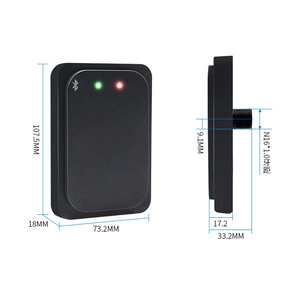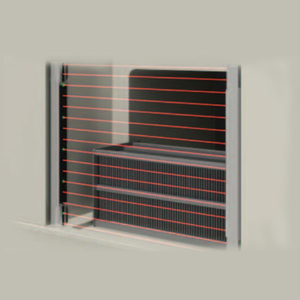
All categories
Featured selections
Trade Assurance
Buyer Central
Help Center
Get the app
Become a supplier

(3626 products available)


















































Safety barrier sensors have several types. Each one is designed for particular applications and environments.
Here are the most common:
Optical Safety Barrier Sensors
These sensors operate by sending and receiving light beams. If any object or person blocks these beams, an alarm will go off or a machine's operation will be halted. This sensor type is widely used in areas where physical barriers cannot be installed. Common places optical sensors are found include factories, warehouses, and some commercial spaces.
Ultrasonic Safety Barrier Sensors
This type of sensor uses ultrasonic waves to detect any movement within a specified range. In practical use, if someone or something enters a danger zone, the ultrasonic wave will be disrupted, triggering the sensor. These sensors are ideal where precise control is needed. Some situations include robotics, automated machinery, and conveyor systems.
Radio Frequency Safety Barrier Sensors
Radio frequency sensors work by transmitting and receiving radio waves. If any object enters the range of the emitted waves, the waves will be interrupted. This interruption will trigger the sensor. These sensors are great for tough environments. Some environments include areas affected by vibration, dust, or temperature variation. They are commonly used in outdoor industrial settings, construction sites, and oil and gas refineries.
Press Safety Barrier Sensors
Press safety sensors are important for machine safety. They are applied in industries that use presses for manufacturing. This includes metalworking and plastics industries. These sensors ensure that operators do not access dangerous areas while the press is active. They work by monitoring the pressure exerted by a person's hand or body. Once the pressure exceeds a set limit, the system will shut down to prevent injuries.
Inductive Safety Barrier Sensors
These sensors use inductive proximity technologies to detect metal objects. These objects could be tools, parts, or any machinery component in motion. They give out a warning or turn off a machine if any detected object is too close to another. Common use cases are areas where machinery parts can pose serious risks. These areas include manufacturing plants, automotive assembly lines, and metal fabrication shops.
Maintaining Safety for Machine Prevention
Safety barrier sensors play a vital role in preventing unauthorized access to active machinery in industrial settings. They create virtual “safety zones.” These zones will automatically shut down equipment if someone enters the danger area. In doing this, they significantly minimize the risk of injury to workers. They also meet safety standards such as OSHA.
Overriding Emergency Situations
In emergencies, safety sensors are critical in helping control systems operate smoothly. They ensure that any attempt to override safety measures will trigger immediate alerts. In high-risk industries like chemical plants or construction, these sensors ensure workers follow strict safety protocols. They, in turn, help prevent accidents and help protect lives in high-stress situations.
Automating Operations in the Absence of Human Control
In many factories, safety barrier sensors automate production processes when workers cannot intervene. These sensors will always monitor workspaces. If a worker is where a machine's moving parts are, the sensor will stop the process until that worker leaves. This automation reduces the need for constant human supervision and keeps workers productive while minimizing risks.
Creating Safe Work Environments for High-Risk Tasks
Industries such as mining, construction, and forestry involve very risky work duties. Fortunately, safety barrier sensors create safer job areas in these industries. They detect when a worker gets close to dangerous equipment or high-risk job areas. They will then sound an alarm or shut down that equipment. They help workers in these jobs do what they need to do without constant worry about injury.
Interfacing with Other Safety Systems
Safety sensors work with other protection systems such as fire alarms and gas leak detectors. They then create a complete safety network. If one sensor detects danger, it will send a signal to the others. For instance, if a safety barrier sensor detects someone getting too close to risky machinery while an emergency alarm goes off, both sensors will shut down the machines in that area.
System Characteristics
These features include the number of channels and the distance between them. Single-channel systems control one place. Multi-channel systems control several areas at the same time. The sensing range is the distance between the sensors and works well. Choose a system with a sensing range that fits the industrial space. Also, select the proper sensor type based on the layout and what poses risks in the area.
Control Unit Specifications
The control unit houses all important system hardware. It also connects the sensors, power, and anything else unique about the system. Note the power supply, output type, and installation choices like the mounting. The control unit should fit the power supplies, like emergency or backup power. Ensure the outputs work with other safety products. Examples include stop switches or alarms.
Barrier Unit Functionalities
The barrier units have the sensors and components to monitor safety zones. These include light curtains, edge sensors, and safety mats. Check the height, length, and number of barriers. Those features will help determine the sensing range and where to fit them in the space. Make sure the barriers fix well in the work area. Ensure they keep workers and equipment safe and boost productivity.
Installation should fit the unique sounds of the work area. Each component must work together to protect the employees. Follow these steps for proper installation:
Maintenance must happen often to keep work systems shielded. Regular checks will enable fast fixes. Follow these rules to ensure proper maintenance and repair:
Regularly Inspect System Components
Often examine sensors, control units, and barriers. Look out for cracks, loose wires, or wear. Always clean dust off sensors. Dust can weaken how well they detect. Also, look for dirty or damaged parts. Damaged parts will reduce detection capabilities.
Testing Prototypes
Conduct regular system tests. Make sure all sensors communicate and react fast. Use test runs to find problems before they cause real danger. Run checks that simulate risks in the space. Confirm sensors react like they should.
Sensor Calibration
Consistently calibrate sensors to maintain accurate detection. Follow the manufacturer's guide to ensure sensors are working well.
Replace Faulty Components
Replace broken sensors and worn parts quickly. Do not let broken barriers stay in use. Fix or swap them before they risk worker safety. Also, ensure all replaced parts match system specs and standards.
Professional Maintenance
Always bring in certified experts for complex safety system checks. Relying on those without skills can lead to wrong fixes. Only professionals who know the system will open and service them.
Commercial buyers should consider many factors when choosing safety sensors for clients in bulk. All these factors affect how well the systems work in various risky environments. It is also important to understand each client's needs and the obstacles in their work areas. Here are some tips for making the best choices:
Assess Industry Needs
First, assess the client's industry. Every industry faces different risks. These include how dangerous the machines are and the layout of the work areas. Take all these factors into account. For instance, factories need sensors that handle fast-moving automation. Construction sites require outside-proof sensors that can withstand weathering. Understanding these industry hurdles will guide the selection process.
Evaluate Sensor Types
Next, evaluate the types of sensors available. One of the most common and widely used in industrial applications are Optical Safety Barrier Sensors. These sensors create protective zones by projecting light beams. If one of these beams gets disrupted, an alarm will go off. Ultrasonic Safety Barrier Sensors are also common. They are popular due to their ability to function in rugged spaces. Radio frequency sensors are also a great option. They can endure harsh conditions like exposure to chemicals or extreme temperatures.
Consider System Scalability
What scalability means is how well a system can adapt as an industry grows or changes over time. MOQ will always consider the average size of the client's operations. It will also think about future growth. A scalable safety system will easily expand or update to keep pace with the rising demands of their workspace. In essence, choosing MOQ with scalable safety systems will ensure long-lasting relevance for clients.
Assess Compliance with Regulations
Safety sensors need to be compliant with all regulations and industry standards. These standards could involve OSHA or ISO requirements. The reason these regulations exist is that they ensure reliable and uniform performance. Always prioritize safety sensors products that comply with these rules. It is important to verify all safety and performance certifications. They will help reduce liability for customers.
Evaluate Maintenance Needs
Always think about what maintenance the sensor systems will require. Complex systems are often costly to maintain. They also require a lot of time to fix. Select sensors with simpler maintenance needs. They will keep work systems running safely with minimal downtime.
A. Safety sensors are made from strong materials like aluminum and some plastics. These parts must be durable to work in tough areas with high humidity and severe temperatures. The weathering they'll face requires it. So, clients should select sensors with housings made from strong materials like these. They will last a long time. The sensors' internal parts also use metals that are easily recycled, like steel.
A. Safety barrier sensors reduce operating costs in the long run by cutting down work injuries and repairing faulty equipment. Since they lower the number of accidents that cause injuries, the safety barriers will reduce costs related to medical bills and legal issues. They will also shut down machines if a worker gets too close to dangerous moving parts. That will lower the chances of expensive equipment damage. Overall, lowering workplace accidents will significantly lower the overall costs of running the business.
A. Yes, all the safety sensors customers select will have many important certifications. These certifications include things like UL, CSA, CE, and ISO standards. They will show that the sensors meet all the safety and performance system requirements. They will also ensure reliability and consistency. So, customers should pick only certified sensors. A proven track record means they are safer and work better than others.
A. Many quick fixes can help clients run their safety sensor systems. They will handle basic troubleshooting like this. For instance, they will identify simple problems. That means they will fix or replace wrongly calibrated, malfunctioning, old, or broken sensors. They will also fix power supply issues. Since it requires them to only access the main control unit. Then, they'll ensure the wires connect properly. Proper tightly secured wires between the sensors and the control unit often fixes them.